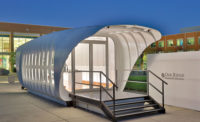Model behavior: A not-so-miniature version of the real thing helps tune a design
From the earliest stages of the project, the client for Jean Nouvel’s Copenhagen Concert Hall, the Danish Radio, had decided that the building’s main auditorium should have a so-called “vineyard configuration,” or one in which stepped blocks of seating surround the stage. Even though there are many shoebox-shaped halls with excellent acoustics, including Amsterdam’s Concertgebouw (Adolf Leonard van Gendt, 1888) and Boston Symphony Hall (McKim, Mead & White, 1900), Danish Radio wanted a vineyard auditorium like the one in Hans Scharoun’s Berlin Philharmonie (1963), along with the more dynamic relationship between audience and performers that such a layout could provide.
 To earn one AIA learning unit, including one hour of health, safety, and welfare (HSW) credit, read each of this month’s Project Portfolio stories and accompanying sidebars. For learning objectives and to take the test click here.
To earn one AIA learning unit, including one hour of health, safety, and welfare (HSW) credit, read each of this month’s Project Portfolio stories and accompanying sidebars. For learning objectives and to take the test click here.Vineyard concert spaces — sometimes referred to as arena-shaped or terraced halls — typically have much more challenging geometry than their more orthogonal counterparts, making acoustical design difficult and requiring intensive analysis. Where shoebox halls rely on their long sidewalls to produce early reflections (those reflected sounds that arrive at the listener’s location within a short time after the direct sound, increasing its apparent loudness), vineyard halls depend primarily on the position and angles of low walls defining each section of seating.
In order to better understand the complex relationship between the room’s size and shape and its acoustics, and the contribution of the low walls in particular, consultant Nagata Acoustics conducted computer simulations. Later in the design process, the firm built a 1:10 physical model of the concert hall. Because of the model’s size, with an interior more than 7 feet tall, consultants could precisely measure actual sound, helping them take into account characteristics that computer simulations generally don’t, such as diffraction and scattering. As a result of the tests, wall angles were slightly adjusted to prevent detrimental echoes. “We typically don’t make dramatic changes with the physical model,” says Yasuhisa Toyota, president of Nagata Acoustics America. “But we use it to do things we can’t do with the computer,” he adds.
Team members conducted the tests by transmitting specialized signals from two small speakers and recording them at receiving points throughout the room. In order to compensate for the model’s scale, they chose frequencies 10 times greater than those that would be produced by an orchestra. And because water vapor in air causes attenuation at such high frequencies, they filled the model with nitrogen to correct this effect. Since air is roughly 80 percent nitrogen, the substitution does not alter important sound characteristics, says Toyota.
Although the model was primarily for acoustical analysis, the architects also found it useful for finalizing design decisions and for explaining the room’s geometry to management, musicians, and contractors, says Stefan Zopp, an Ateliers Jean Nouvel partner. “Before building at 1:1,” he says, “it helps to have this understanding.”



Post a comment to this article
Report Abusive Comment